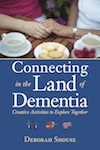Insider’s Tips for Analyzing Activities Programs
My mother had been an artist in her later years, but she stopped painting when she began living with memory loss. Instead, she took comfort in listening to music and in nurturing a baby doll. Ron’s dad studied architecture as a young man, but never had the leisure time to pursue drawing or art. When he moved into a memory care community, he flourished in the Memories in the Making painting program. We worked hard to find care homes that nurtured our parents and my background in healthcare helped us develop a few insider’s tips for analyzing activities programs.
“Families need to share information about favorite hobbies and they also need to be ready for their loved one to try new things and possibly change interests,” says Alisa Tagg, President of the National Association of Activity Professionals. Alisa has helped dozens of facilities build meaningful activity programs.
Here’s an example of how one woman thrived on learning a new skill and giving back:
Mary’s family was amazed when she got involved in a jewelry-making class in the memory care unit. Mary had never thought of making jewelry and she never even wore necklaces, bracelets, or earrings. But she loved beading and was thrilled to share her creative designs with others. Producing something beautiful for others motivated Mary. The facility helped her sell her jewelry and she contributed the money to the activities budget and also donated to charity.
Alisa knows how emotionally challenging it is for families to find good care facilities for their loved ones. Here are some of her insider’s tips for analyzing activities program.
See For Yourself
“You have to view what is going on in the activity room,” she says. “See how the staff interacts with the residents. If there’s an entertainer, is the staff in the back of the room, charting and talking? Or are they in the front, dancing, and singing and engaging with residents and families?”
Look at the activities calendar. Visit the facility at different times and on various days and see if the activities in progress match the scheduled events.
Encourage Engagement
Study the schedule to see how often the residents are engaged, rather than just being entertained. Are they invited to contribute to community service projects? Are they going to sing-alongs or helping with baking projects? People with memory deficits need a variety of activities. Look for a variety of programming that balances the four areas of wellness—spiritual, mental, physical, and emotional.
Visit Programs of Interest
Visit the programs you think your loved one might enjoy.
Find out how many staff members assist in the activities program.
Does the care staff seem aware of the importance of activities? Is there one-on-one assistance for those who want to participate and need extra attention?
Watch for Independent Projects
Is there a place for puzzles, games, cards, and other things people can enjoy independently? Are there opportunities for residents to contribute to their community and to help others around them?
Share Questions and Concerns
“Every facility should have a plan of care meeting, where family can share their expectations and concerns with the nursing staff,” Alisa says. “Ask how your loved one is doing. Share your insights.
A good facility will welcome that meeting.”
Stay Involved
Stay as involved as you can. Helping your loved one connect through meaningful activities may involve trial and error. Get to know the other residents and their families. You’ll stay engaged with your loved one and create a sense of community with a lot of other wonderful people as well. #
To learn more about Alisa Tagg, BA ACC/EDU AC-BC CADDCT CDP and the National Association of Activity Professionals, visit https://naap.info
To delve into creative activities do you can on individual visits, read my latest book, Connecting in the Land of Dementia: Creative Activities to Explore Together.


